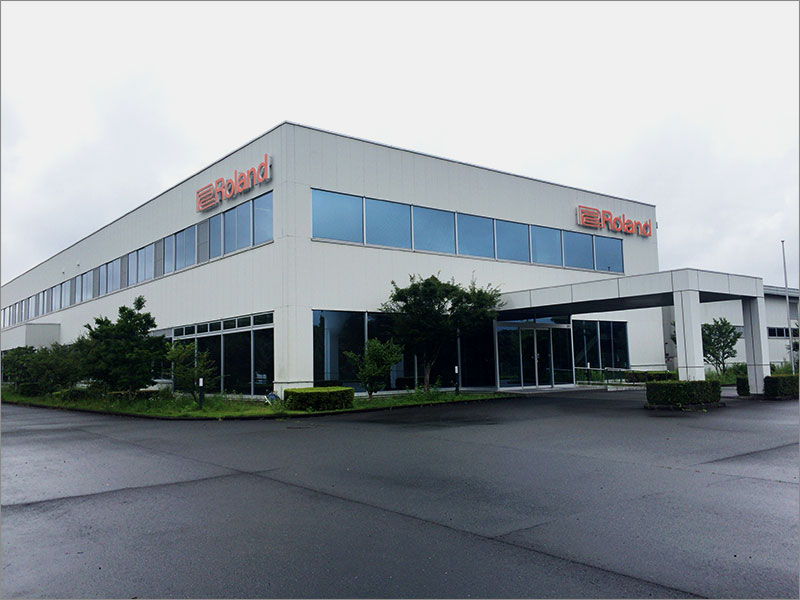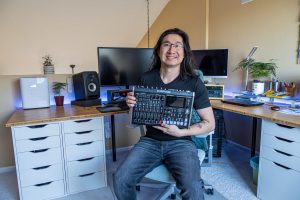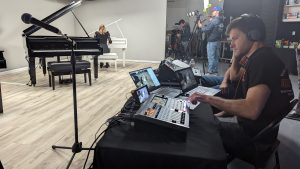- The Hamamatsu area is the home to many Japanese manufacturers in fields such as automobiles, musical instruments, and other electronic devices.
- The Roland Miyakoda factory was built in 1997, and initially manufactured digital pianos.
- A proprietary IT system has been implemented to support the workers in this production process.
- In preparing for mass production, the production technology team works with the product development team to set up the RITHM system
The Hamamatsu area is the home of many Japanese manufacturers in fields like automobiles, musical instruments, and other electronic devices. Roland, too, has its main office, laboratories, and factories in this area. In recent years, Japanese manufacturers have been moving their production offshore. Roland is no exception and produces most of its musical instruments outside Japan.
Made in Japan
The Roland Miyakoda factory was built in 1997 and initially manufactured digital pianos. It now produces only a few musical instruments. All commercial A/V devices come from the Miyakoda factory. The V-series and VR-series of switchers and mixers are stamped “Made in Japan,” a reputation the world has come to know and appreciate. The team gives a tour of the production process.
The V-series and VR-series of switchers and mixers are stamped “Made in Japan,” a reputation the world has come to know and appreciate.

Two Main Processes
Typical production methods in a factory can be broadly classified into two main processes. First, there is assembly line production in which the workpiece flows along a line through a series of steps until completion. The second process is cell production, during which one person or a small group of people assemble the product until completion. There are approximately 20 commercial A/V models produced at the Miyakodai factory. This low number of models is best suited for cell production. A key advantage of cell production is that it allows rapid changes in production volume. Keeping an eye on marketplace demand, the factory decides how many units of which model can be produced on any given day. On the day of our visit, the V-02HD and the V-600UHD were being produced.
A proprietary IT system has been implemented to support the workers in this production process. A computer-assisted system named RITHM (Roland IT-based Hi-end Monozukuri) [“monozukuri” is a Japanese word meaning “making things”] guides the workers’ step-by-step process. RITHM uses a combination of sound and lights to prevent errors because even the best worker can make mistakes. The workers appreciate the system as it is quite unusual for a process to be created with such thoughtful care for integration between machinery and humans.

A proprietary IT system, a computer-assisted system named RITHM, has been implemented to support the workers in this production process.
RITHM System
In the course of preparing for mass production, the factory production technology team works with the product development team to set up the RITHM system. The development team is located approximately 30 minutes by car from the Miyakoda factory. The Lead Product Manager commutes to the factory on a near-daily basis when production of a model is starting up.
For example, the V-02HD has a complex and precise construction that involves multiple metal plates being bent and fastened together with screws. During the course of production, it was sometimes impossible to understand the differences in the tolerance between assembled parts. Inconsistencies may have appeared that had not been seen until mass production began. It seems characteristic of the Japanese people that they notice the details. The development team places trust in the factory workers, saying, “The people at Miyakoda don’t overlook things.”

No Compromise
Since the V-600UHD is the first product that supports 4K Ultra High Definition, the initial step was to choose a testing and measuring device that supported 4K. The chassis of the unit is larger than most other Roland video products. Early in RITHM formation, assembly caused frame bending depending on the order of the screws being tightened. This issue was resolved with the factory production technology team.
When the development team says, “If they give the OK, we can relax,” they’re referring to the testing center that adjoins the Miyakoda factory. This is where various tests are performed to a strict standard, including electromagnetic radiation, static electricity, and drop tests.
Close cooperation between development, production, and quality assurance guarantees the high quality of Roland’s video devices. This visit provides a concrete example of the advantages of domestic output within Japan. The photos tell the story of the production process.
Close cooperation between development, production, and quality assurance guarantees the high quality of Roland's video devices.
Receiving and Picking Parts
Assembly
Shipment Inspection





